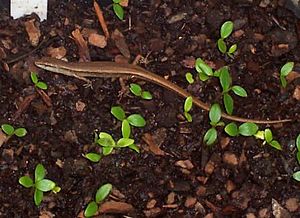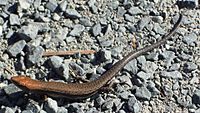Delicate skink facts for kids
Quick facts for kids Delicate skink |
|
|---|---|
 |
|
| Conservation status | |
| Scientific classification | |
| Genus: |
Lampropholis
|
| Species: |
delicata
|
The delicate skink is a small lizard. It is also called the garden skink or rainbow skink. Its scientific name is Lampropholis delicata. This skink first came from Eastern Australia.
You can often find delicate skinks in gardens. They have a medium-sized body and a thin tail. Their scales feel smooth. Their back and sides are usually greyish-brown or rich brown. They often have darker or lighter spots. Sometimes, a thin yellowish-brown stripe runs along their back.
Where Delicate Skinks Live
Delicate skinks are originally from Eastern Australia. They were accidentally brought to New Zealand in the 1960s. Now, you can find them in many parts of New Zealand's North Island. They are considered an invasive species there. This means they compete with native lizards and other animals for food and places to live. They have also spread to Hawaii and Lord Howe Island. In Hawaii, they are now the most common skink!
Cool Colors and Patterns
Delicate skinks can have different colors and patterns. This is called color dimorphism. There are two main types:
- Some skinks have a clear white stripe along their side.
- Others have no stripe, or a very faint one.
Male skinks often have a less clear stripe than females. The stripe helps them blend in with their surroundings. This is called camouflage. It helps them hide from predators.
Why Different Colors?
Scientists think several things might cause these color differences:
- Blending In: The stripe might help females hide better. But for males, a bright stripe might make them easier to spot. So, more males are plain, or have a duller stripe.
- New Environments: When skinks move to new places, like New Zealand or Hawaii, they face different climates. Delicate skinks are more active when it's cooler. Males that are more active in cooler places often have less distinct stripes. This might help them avoid predators.
- Habitat: These skinks like open areas with lots of leaves on the ground. This helps them control their body temperature. It also gives them places to hide and find food. Their colors help them blend into the leaves.
The environment plays a big role in how these skinks look. These different patterns help them survive in various places. This is especially important because they are an invasive species in some areas.
Gallery
- A Complete Guide to Reptiles of Australia - Steve Wilson & Gerry Swan ISBN: 1-876334-72-X




